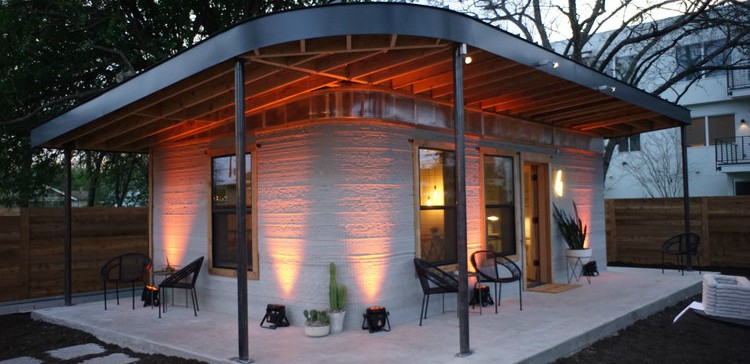
A start-up company based in Austin has come up with an enterprising solution to tackling the worldwide problem of homelessness – and the idea may reach much further than just charity work. ICON has been working hard at using 3D-printing to construct houses, and it looks like they may start appearing in El Salvador as early as next year.
Showcased at this year’s SXSW event, the company’s method can see a 650 square-foot, single-storey house printed using a Vulcan printer and cement – a material chosen for its sturdiness. The entire process, from start to finish, takes between 12- and 24-hours, and costs approximately US$10 000.
However, the company is looking at ways to reduce the cost to as little as US$4000 per house. Clearly, this idea will not just revolutionise how charities and other organisations tackle the problem of people without homes, but it could also transform the entire construction industry. Of course, there would be no reason to stop at houses either. As the tech improves, we may start seeing 3D-print buildings used for all sorts of quality entertainment, such as movies, casino games, or even restaurants.
First Model to Be Trialled
ICON has yet to put its seemingly brilliant idea to the test, however, that looks set to happen soon. Speaking at the event, company co-founder Jason Ballard said the first model will be used by the company as an office.
According to Ballard, part of the trial process will include testing the quality of the air within the building, as well as the appearance of the building. As much as the co-founder supports the latest technology, he also has a passion for green living. His other company, Treehouse, renovates and upgrades residences and other buildings in sustainable, eco-friendly ways.
A Look at the 3D-Printed House
Although the initial houses to be 3D-printed are 650 square feet in size, the company claims the size of the houses can be increased to as much as 800 square feet. This is more than impressive, considering a typical New York City apartment is only 66 square feet larger.
The first model that will be created by ICON will include a living space, as well as a bathroom and a bedroom. There is even a curved porch for some outdoor living.
The Planned El Salvador Trial
The housing charity through whom the company will test out its unique 3D-printed houses in El Salvador is New Story. Based in San Francisco USA, the charity has spent 3-years building proper housing structures to replace informal shanty structures in the underprivileged country, a third of whose population is reportedly homeless.
Perhaps even more surprising than ICON’s pioneering method of 3D-print construction is that New Story has been working with the company for less than a year. It was a relationship that could not come soon enough for the charity, as it has managed to build only 100 homes every 8 months, at a cost of roughly US$6000 per home.
If the El Salvador trial proves that ICON’s idea is a viable one, the low-cost, quickly-constructed homes will also start appearing in other countries plagued with high numbers of homeless people, such as Bolivia, Haiti, and Mexico. The company’s Vulcan printer will be moved to El Salvador once the initial trial process has been concluded, and ICON has made the necessary alterations to the design.
People Before Profits
That the company’s intent on 3D-printing houses for the homeless of various counties first is a clear indication that the idea and the initial project put people before profits. This is quite opposite to the usual scenario, in which majority innovations are first available only to those who can afford them. In this case, the rich will have to wait until a good number of homeless people have a roof over their heads.
New Story founder, Alexandria Lafci, said she believes technological innovation can benefit the greater good in countless ways. Expressing her support of ICON’s ground-breaking work, she added that the project was keeping with the ways in which mobile tech’s penetration of the greater African market has been widely used as a force for change.
However, going beyond the immediate plans to limit the 3D-printed houses to the underprivileged, Lafci continued, that 3D printing will become a popular means of building houses, and it may well be a game changer in every construction sector globally.
Image source:
https://static1.squarespace.com/static/5aa5807ab27e397a4cef6c2b/5aa6adef0d9297ee20806e15/5aa6adf5c8302517fb401258/1520882136539/First_Permitted_3DPrintedHome_US.JPG?format=750w
YouTube:



























